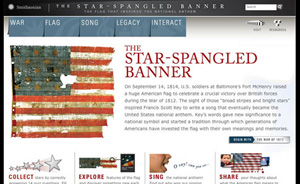talking history | syllabi | students | teachers | puzzle | about us
The Star-Spangled Banner: The Flag That Inspired the National Anthem
http://americanhistory.si.edu/starspangledbanner/
Created and maintained by the National Museum of American History, Kenneth E. Behring Center, Washington, D.C.
Reviewed Sept. 2008.
In 1998, the Smithsonian Institution’s National Museum of American History (NMAH) launched a multimillion-dollar effort to preserve the Star-Spangled Banner. A victim of its own popularity, the flag had suffered from too many years on continuous display. With Polo Ralph Lauren providing significant funding (together with the Pew Charitable Trusts and Save America’s Treasures at the National Trust for Historic Preservation), a tremendous conservation project commenced. The flag remained on display in a glass-walled lab that allowed visitors to watch as conservators working to undo years of damage cleaned and stabilized the fabric. The exhibit closed during the recent $85 million renovation to the museum; when the NMAH reopens, the flag will become part of a new permanent exhibition, “For Which It Stands: The American Flag in American Life.”

Aimed at upper elementary and middle school children and their teachers, the Web site under review tells the story of the Banner’s history, and of the U.S. flag more generally, while also describing the massive conservation effort required to preserve the artifact. A section titled “You Solve the Mystery” presents three historical questions and supplies documents that users may read to formulate an answer, as well as a link supplying the Smithsonian’s answer. Elsewhere, a quiz allows readers to check their comprehension of the site’s material. The site also links to a teacher’s manual developed by the History Channel, another supporter of the NMAH effort.
Adults may find snippets of intriguing information here, but by and large the site’s organization makes for choppy reading for more sophisticated users. The site features one short paragraph per page generally (indeed, many land at exactly one hundred words, making the charge to the authors somewhat too transparent) with links to three or four follow-up pages, each with their own paragraph and links. The most absorbing prose describes the conservation effort. Here, the text is longer (and decidedly more technical, suggesting that the intended audience for this material is a more sophisticated one than for the rest of the site), and detailed images of the deteriorating fabric provide a fascinating glimpse into the skills and scientific knowledge needed to understand and care for the flag. A fascinating look at the “science of preservation,” which walks readers through the meticulous series of steps required to assess and conserve the fabric, makes one wish that the conservators had blogged their work, which must have included moments of both triumph and despair. Indeed, though the site seems to assume history students and teachers as its main audience, science teachers may well find as much or more here to excite students' imaginations.
That said, the site may already be preparing for its own demise. When it was reviewed in September 2008, the site was no longer accepting comments from viewers, and the link to past comments was down. Perhaps this material will be incorporated into a new site associated with “For Which It Stands.” If so, its creators would be wise to retain and expand the discussion of the flag’s conservation and ongoing preservation, affirming for students the ways science and history are intimately intertwined.
Marla R. Miller
University of Massachusetts
Amherst, Massachusetts
